【冲刺2014】英语专题辅导与训练课件:2[1]3 短文改错(通用版)(共52张PPT)
文档属性
| 名称 | 【冲刺2014】英语专题辅导与训练课件:2[1]3 短文改错(通用版)(共52张PPT) |  | |
| 格式 | zip | ||
| 文件大小 | 1.1MB | ||
| 资源类型 | 教案 | ||
| 版本资源 | |||
| 科目 | 英语 | ||
| 更新时间 | 2014-02-16 20:17:13 | ||
图片预览


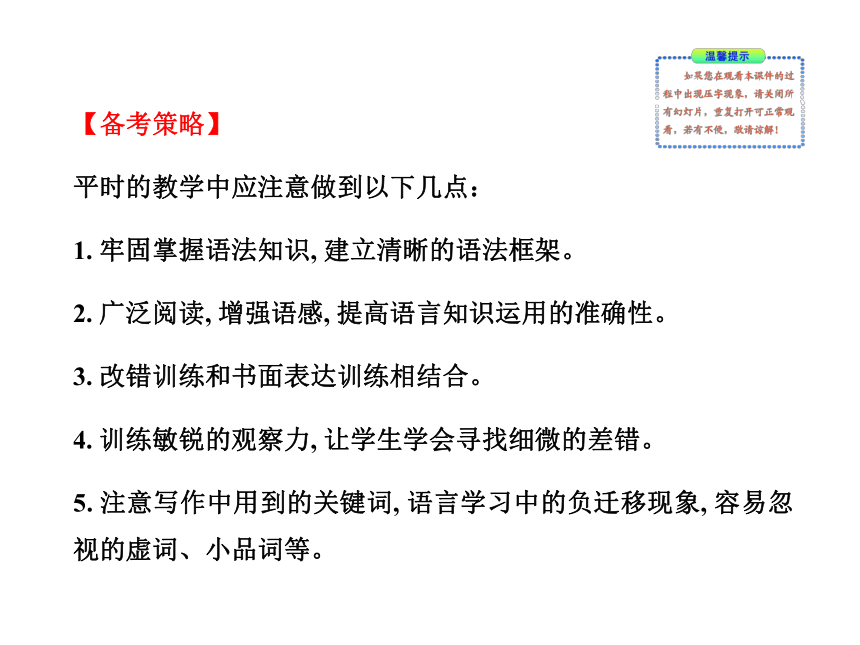


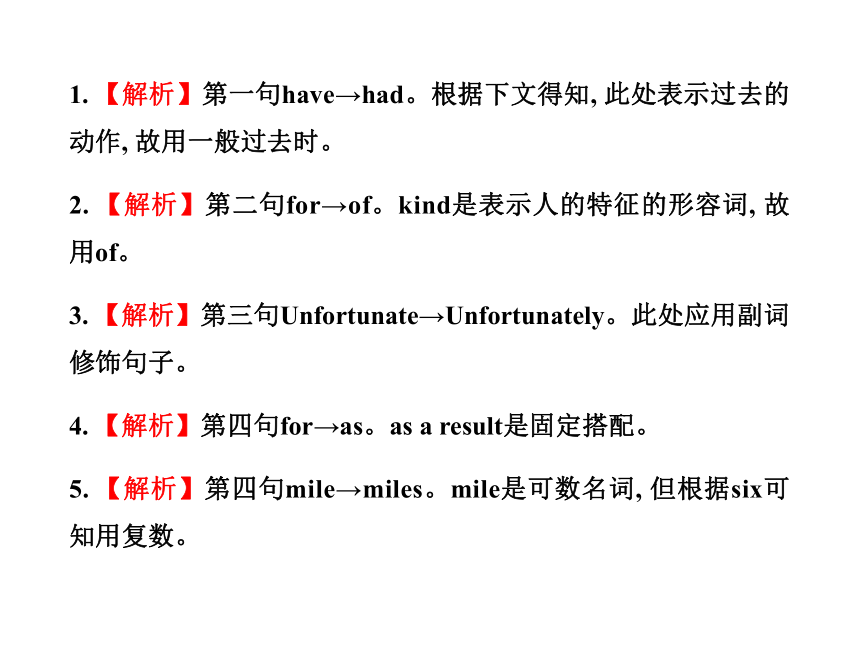


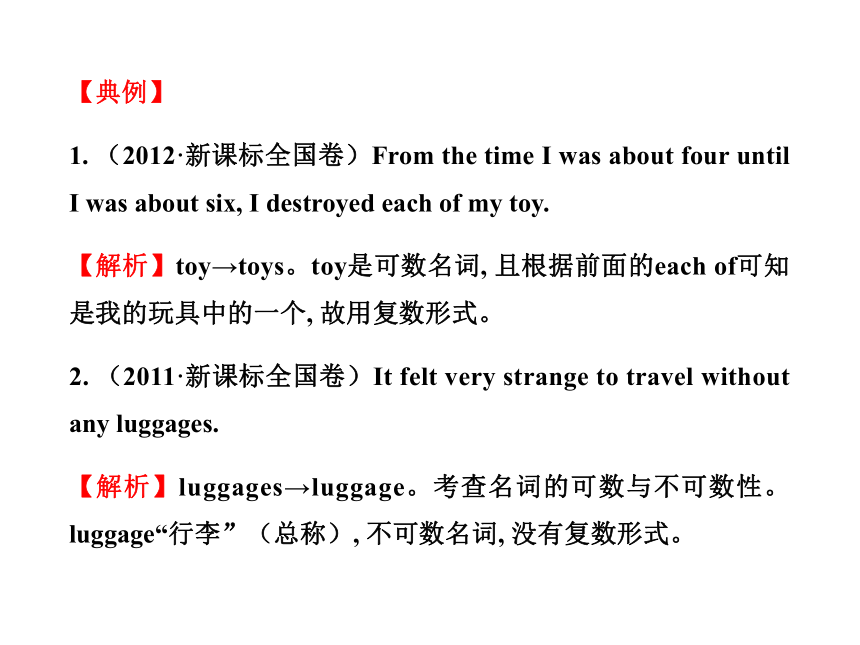

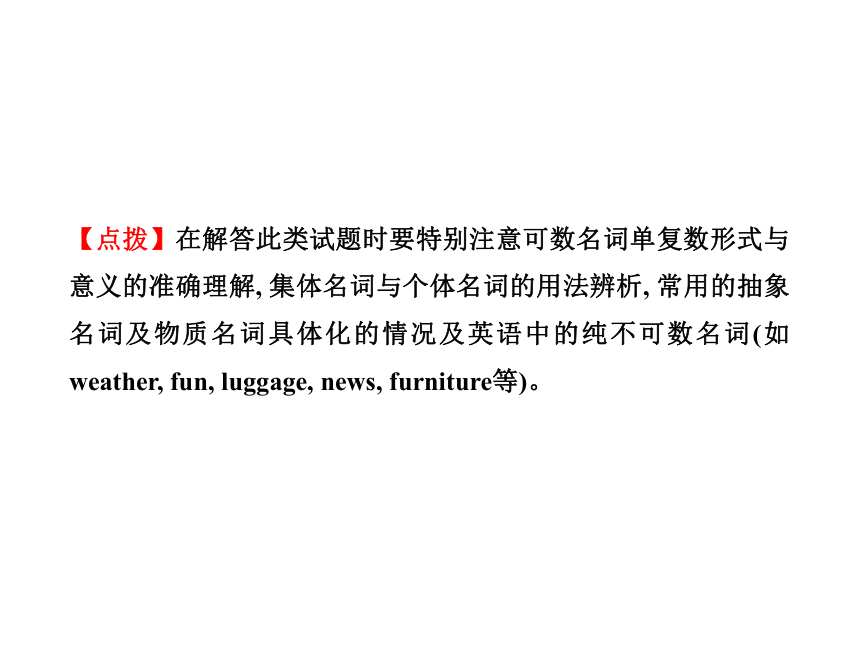
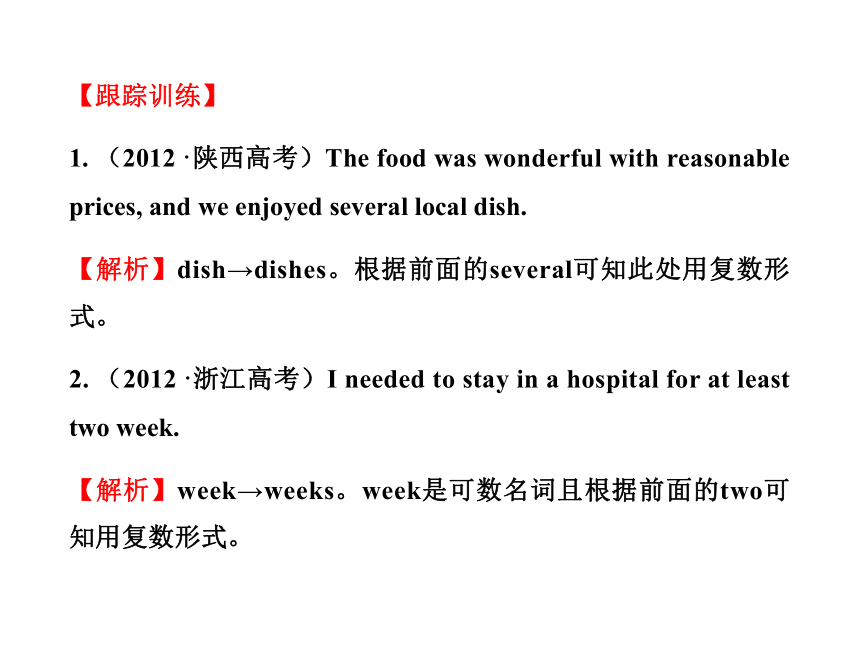
文档简介
课件52张PPT。Ⅲ. 短文改错【备考策略】
平时的教学中应注意做到以下几点:
1. 牢固掌握语法知识, 建立清晰的语法框架。
2. 广泛阅读, 增强语感, 提高语言知识运用的准确性。
3. 改错训练和书面表达训练相结合。
4. 训练敏锐的观察力, 让学生学会寻找细微的差错。
5. 注意写作中用到的关键词, 语言学习中的负迁移现象, 容易忽视的虚词、小品词等。【典题自测】
2012·辽宁高考
Dear Diana,
Thank you for the lovely day we have with you. It was so kind for you to let us bring Anne’s friend, Gina. Unfortunate, the only problem was the journey home. There had been a terrible accident on the highway and, for a result, there was a long line of traffic for at least six mile. In the end, we drove to aservice station and waited there unless the road was clear. In the car park here Gina nearly got knocked over as car drove out far too quickly from behind a lorry. They finally dropped Gina off at her parents’ and made our own way to home.
Much love,
Fiona1. 【解析】第一句have→had。根据下文得知, 此处表示过去的动作, 故用一般过去时。
2. 【解析】第二句for→of。kind是表示人的特征的形容词, 故用of。
3. 【解析】第三句Unfortunate→Unfortunately。此处应用副词修饰句子。
4. 【解析】第四句for→as。as a result是固定搭配。
5. 【解析】第四句mile→miles。mile是可数名词, 但根据six可知用复数。6. 【解析】第五句unless→until/till。根据上下文可知, 此处表示“我们一直等到路上空了为止”。unless表示“除非”, 不符合逻辑。
7. 【解析】第六句here→there。根据上下文可知, 此处表示“在那里”, 故用there。
8. 【解析】第六句as后加a。car是可数名词, 此处表示一辆汽车冲过来。
9. 【解析】第七句They→We。整篇文章用的是第一人称。
10. 【解析】第七句去掉to。此处home为副词, 前面不加介词。【考点归纳】
【考点1】名词
名词的考查主要集中在以下几个方面:
1. 可数名词与不可数名词的混用。
2. 可数名词的单复数的错用。
3. 名词的格的误用。
4. 抽象名词/物质名词具体化的用法。【典例】
1. (2012·新课标全国卷)From the time I was about four until I was about six, I destroyed each of my toy.
【解析】toy→toys。toy是可数名词, 且根据前面的each of可知是我的玩具中的一个, 故用复数形式。
2. (2011·新课标全国卷)It felt very strange to travel without any luggages.
【解析】luggages→luggage。考查名词的可数与不可数性。luggage“行李”(总称), 不可数名词, 没有复数形式。3. (2011·浙江高考)I was playing at my cousin house.
【解析】cousin→cousin’s。考查名词所有格。根据句意应是“在我堂兄家的房子里”, 表示“……的”用名词所有格的形式。【点拨】在解答此类试题时要特别注意可数名词单复数形式与意义的准确理解, 集体名词与个体名词的用法辨析, 常用的抽象名词及物质名词具体化的情况及英语中的纯不可数名词(如weather, fun, luggage, news, furniture等)。【跟踪训练】
1. (2012·陕西高考)The food was wonderful with reasonable prices, and we enjoyed several local dish.
【解析】dish→dishes。根据前面的several可知此处用复数形式。
2. (2012·浙江高考)I needed to stay in a hospital for at least two week.
【解析】week→weeks。week是可数名词且根据前面的two可知用复数形式。【考点2】冠词
冠词的考查主要集中在冠词a, an, the的混用及漏用等方面。【典例】
1. (2012·陕西高考)It is such great hotel that I will recommend it to any friend of mine who is going to Beijing.
【解析】在great前加a。hotel是可数名词单数, 第一次提到在great前加不定冠词a。2. (2011·辽宁高考)When, however, on Monday, January 16, a science fiction film about visitors from outer space was shown on television, there was the immediate increase in reports of sightings from all parts of the States.
【解析】第一个the→an。考查冠词的用法。有关目击外星人的报道有了一个迅速的增长, 表泛指, 用an。【点拨】不定冠词a/an往往表示“数量、泛指”, 当一个名词意为“一个, 一次, 一组”等数量时, 往往用不定冠词;定冠词the往往表示“特指, 心目中知道的某个事物”等, 当被非谓语动词、定语从句修饰时, 此名词往往表示特指。另外, 一些短语中用不用冠词意义有很大区别。例如:【跟踪训练】
1. (2012·浙江高考)As a result, nobody knew truth.
【解析】truth前加the。根据句意可知应是知道前文叙述的真相, 故用the表示特指。
2. (2011·新课标全国卷)I was going to visit a friend there and after that I would go to Xiamen for long holiday.
【解析】在long前加a。考查冠词的用法。holiday为可数名词, 根据句意此处holiday应为单数形式, long前面加不定冠词a, 意为“我将去厦门度一个假”。【考点3】代词
对代词的考查主要集中在人称代词、物主代词、反身代词、不定代词的误用及混用等方面。【典例】
1. (2012·新课标全国卷)I was happy when the toys worked, but when things went wrong, I got angry and broke it.
【解析】it→them。根据前文的toys可知此处用代词them。
2. (2012·陕西高考)It is such a great hotel that I will recommend it to any friend of me who is going to Beijing.
【解析】me→mine。双重所有格的构成是of +名词性物主代词或名词所有格。【点拨】此类试题的解决方案:
1. 顺藤摸瓜, 理清短文中代词的指代关系, 注意联系上下文。
2. 系统掌握it的各种用法。
3. 准确把握不定代词在文中的正确使用。【跟踪训练】
1. (2010·陕西高考)As she did this, lots of tea splashed on his T-shirt!
【解析】his→her。考查代词的用法。句意:当她做这件事时, 许多茶水溅在了她的T恤衫上。此句表述的是一位女士, 所以应该把his改为her。2. (2010·四川高考)And after many attempts, she passed her driving test and told her husband that, to celebrate, he was going to drive him over to France for a holiday.
【解析】he→she。考查代词指代性别的用法。句子表达的意思为:妻子开车带着丈夫去法国度假, 所以应该用指女性的she。【考点4】形容词与副词
对形容词和副词的考查主要集中在以下两个方面:
1. 形容词和副词的误用。
2. 原级、比较级和最高级的误用。【典例】
1. (2012·新课标全国卷) I learned early in life that I had to be more patient and little aggressive.
【解析】little→less。根据句意“我不得不多一些耐心, 少一些好斗”可知, 此处用less。
2. (2012·浙江高考)Unfortunate, I had an accident and hit another car.
【解析】Unfortunate→Unfortunately。用副词作状语。【点拨】在解答此类试题时, 应掌握以下几点:
1. 修饰名词要用形容词。
2. 修饰动词、副词、形容词或整个句子用副词。
3. 结合语境注意比较级和最高级的使用。【跟踪训练】
1. (2012·陕西高考)We lived in a comfortably double-room with a big bath.
【解析】comfortably→comfortable。修饰名词double-room, 应用形容词。
2. (2011·浙江高考)Late on, my aunt drove me home.
【解析】Late→Later。考查late与later的区别。句意:后来, 我姑姑开车送我回家了。late意为“晚的, 迟到的”;later意为“后来”, 经常和on连用构成短语later on, 意为“后来, 之后”。3. (2010·陕西高考)I had to try hardly not to laugh at her shocked face!
【解析】hardly→hard。考查副词词义。句意:我尽力不去笑她吃惊的面孔!句中hardly意为“几乎不”, 虽然词性是副词, 但不符合句子意思。try hard to do sth. 意为“尽力去做某事”, 符合题意。【考点5】动词
对动词的考查主要集中在:
1. 动词的时态和语态错误。
2. 主谓不一致的错误。
3. 非谓语动词的误用。【典例】
1. (2012·陕西高考)My father and I stayed at the South Lake Hotel for a week when we visit Beijing last month.
【解析】visit→visited。根据时间状语last month可知本句时态是一般过去时, 故动词用过去式。
2. (2012·新课标全国卷)Meanwhile, I found out that with more patience I could make my toys to last.
【解析】去掉last前的to。make“使, 让”, 其后用省略to的不定式作宾语补足语。【点拨】在解答动词类练习时要从以下几个方面入手:
1. 纵观全文或全句, 明确句中动词所作的句子成分。
2. 把握好文章的主体时态, 注意上下文中所用的动词时态的提示及句子中所用的时间状语。
3. 注意一些用主动形式表示被动含义的动词或短语, 如consist of; belong to; date back to; be worth doing等。
4. 系统掌握非谓语动词的句法功能。
5. 前后联系, 整体把握。【跟踪训练】
1. (2011·新课标全国卷)I feel very happy that I could change my clothes at last.
【解析】feel→felt。考查动词时态。根据下文中的could可知, 此处应该用过去式。
2. (2010·全国卷Ⅰ) My teachers have been telling me how great my writing was.
【解析】have→had。考查动词时态。句意:我的老师们一直告诉我, 我的写作非常棒。根据telling me后面的宾语从句的时态来看, 谓语动词have been telling中的have应该改为had, 以保持时态的一致性。3. (2011·浙江高考)I would never be able to enjoy to playing with the toy or face my cousin again.
【解析】把第二个to去掉。考查动词enjoy的用法。enjoy后跟动名词形式, enjoy doing sth. 意为“喜欢做某事”。【考点6】介词和介词短语
对介词考查主要集中在介词短语和习惯用法的搭配两个方面。【典例】
1. (2012·新课标全国卷)That’s it. No more toys to you.
【解析】to→for。给某人的玩具用for。
2. (2012·陕西高考)I also shared for my friends many photos taken in Beijing.
【解析】for→with。动词share常与介词with构成搭配, 意为“和某人分享”。【点拨】在平时的学习中应从以下几个方面入手:
1. 注意积累语言知识, 特别是一些固定搭配的记忆。
2. 强化语法训练, 分清连词、副词和介词之间的区别和句法功能。
3. 将语法知识的记忆和语感的培养结合起来。【跟踪训练】
1. (2011·陕西高考)I was really disappointed and about to leave when he walked out a building.
【解析】在out后加of。考查介词搭配。句意:我非常失望, 正要离开, 就在那时他从一栋楼中走了出来。walk out of意为“从……中走出来”, 固定搭配。2. (2011·新课标全国卷)Luckily I had all my money on my pocket.
【解析】on→in。考查介词用法。句意:幸运的是, 我把所有的钱都放在了口袋里。in one’s pocket意为“在口袋里”, 用介词in表达此意。on表示“在事物的表面”, 而in指“在……内部/里面”。【考点7】连词
此考点主要是运用行文逻辑, 考查连接词。
谨记两种句式:并列句(并列连词), 复合句(从属连词);
六种关系:转折关系, 选择关系, 递进关系, 并列关系, 因果关系, 同位关系;
一种变化:语意的曲折变化。例如:肯定与否定, 方位与时空的转移等。【典例】
1. (2012·新课标全国卷)But before long they began to see which was happening.
【解析】which→what。考查连词的用法。根据句意应是看到了所发生的一切, 并非哪一个, 故用what。
2. (2010·浙江高考)After we left, I said, “That was very nice of you, Mother. So I didn’t think she looked like Grandma. ”“Neither did I, ” said Mother cheerfully.
【解析】So→But。考查行文逻辑。根据前后语境, 此处应表示转折关系。【点拨】短文改错对连词的考查仅限于上下文之间语意的连贯方面。所以在做这类题目时, 重要的是要读懂上下文, 搞清楚上下句之间的关系。掌握句式结构, 把握准语意关系是做好此类试题的关键。如并列逻辑关系常见的词有and, both. . . and. . . , not only . . . but also . . . , as well as等;转折逻辑关系常见的词有however, but;递进逻辑关系常见的词有what’s more, moreover, besides等。【跟踪训练】
1. (2012·浙江高考)I called my parents, so I did not tell them what had happened.
【解析】so→but。上下文之间是转折关系, 故用but。
2. (2011·陕西高考)I didn’t have my camera with me at that time, but I rushed back home to get it.
【解析】but→and/so。考查连词用法。句意:那时候我没有带着相机, 所以我跑回家去拿了。根据句意可知, 上下句之间表示并列或者因果关系, 并不是转折关系。3. (2011·辽宁高考)There was a rapid drop in the number of reported sightings, because the rate remained above the previous level.
【解析】because→although/though/yet/but。考查上下句之间的语意连贯。句意:虽然报道率仍旧保持在以前的水平之上, 但是在报道的数量上有快速的下降。 (一)通读全文, 掌握大意
要快速阅读全文, 注意语境和有关提示。短文改错题的语篇意识年年在强化, 错误常常“隐藏”在短文中, 因此要集中精力, 努力进入阅读状态和文章角色, 迅速提炼、优化短文中的直接信息和间接信息, 激活有关背景知识。 (2011·辽宁高考)
In early January this year, the rate of UFO reports were steady, around three per weeks. When, however, on Monday, January 16, a science fiction film about visitors to outer space was shown on television, there was the immediate increase in reports of sightings from all parts of the States. The commanding officer, Wayne Tyler, who directly responsible for the study of all such reports, decided to making his findings known. They wrote an article, which said that all UFO reports could be explained for quite naturally by aircraft movements. Follow this explanation, there was a rapid drop in the number of reported sightings, because the rate remained above the previous level.
通读全文可知本文主要介绍了UFO方面的有关知识。文章主体运用了过去时, 人称是第三人称。 (二)整句理解, 上下兼顾
要在规定的时间之内, 注意以句子为单位, 分析文章中前后句和上下文的逻辑关系, 运用所学知识多角度、多层次地去发现问题和解决问题。改错的过程是在一个特定的语境中进行的, 考生在对文章进行阅读并基本理解之后, 对难句、长句, 要从语法的角度对句子成分进行分析。对于那些还不能立即作答或自我感觉比较困难的题目, 不必拘泥于其顺序排列。随着对文章具体语言情境的逐渐把握, 随着题目的答题范围逐步缩小, 就会有豁然开朗、茅塞顿开的感觉。 (三)对照答案, 复读全文
注意检查修正后的文章是否意思通畅、结构完整。要排除答题不会有错或答题有错也难以发现的思维定势的干扰, 认真对照答案, 从头到尾快速通读一遍, 进一步加深对文章的理解, 检查修正后的文章是否意思通畅、结构完整, 是否前后联系、首尾呼应。
对无把握的题目, 考生也要根据对文章信息的整合, 试着从上下文、语感、语法和词义等多角度来进行分析、推断, 迅速进行优化决断。1. 【解析】第一句的were→was。考查主谓一致。此句的主语是the rate, 谓语动词用单数, 而且根据时间状语In early January this year可知要用过去时。
2. 【解析】第一句的weeks→week。考查名词的数。per/every /each后要加名词的单数形式。
3. 【解析】第二句的to→from。考查介词的用法。根据上下文可知外星人是“来自于”外太空, 要用from。
4. 【解析】第二句的the→an。考查冠词的用法。有关目击外星人的报道有了一个迅速的增长, 是泛指, 用an。5. 【解析】第三句的who后加was/is。考查固定结构。be responsible for对……负责。
6. 【解析】第三句的making→make。考查固定结构。decide to do sth. 决定干某事。
7. 【解析】第四句的They→ He。考查代词。根据上文是指The commanding officer, Wayne Tyler写了一篇文章, 要用代词He。
8. 【解析】第四句去掉for。考查介词的用法。quite naturally为副词, 前面不加介词;explain后也不跟介词。9. 【解析】第五句的Follow→ Following。考查非谓语动词。分析句子结构可知Follow. . . 作伴随状语, 而且Follow与逻辑主语之间的关系是主动的, 要用v. -ing形式。
10. 【解析】第五句的because→ though/although/but/yet。考查连词辨析。根据句意可知前后两句是转折关系, 而不是因果关系。
平时的教学中应注意做到以下几点:
1. 牢固掌握语法知识, 建立清晰的语法框架。
2. 广泛阅读, 增强语感, 提高语言知识运用的准确性。
3. 改错训练和书面表达训练相结合。
4. 训练敏锐的观察力, 让学生学会寻找细微的差错。
5. 注意写作中用到的关键词, 语言学习中的负迁移现象, 容易忽视的虚词、小品词等。【典题自测】
2012·辽宁高考
Dear Diana,
Thank you for the lovely day we have with you. It was so kind for you to let us bring Anne’s friend, Gina. Unfortunate, the only problem was the journey home. There had been a terrible accident on the highway and, for a result, there was a long line of traffic for at least six mile. In the end, we drove to aservice station and waited there unless the road was clear. In the car park here Gina nearly got knocked over as car drove out far too quickly from behind a lorry. They finally dropped Gina off at her parents’ and made our own way to home.
Much love,
Fiona1. 【解析】第一句have→had。根据下文得知, 此处表示过去的动作, 故用一般过去时。
2. 【解析】第二句for→of。kind是表示人的特征的形容词, 故用of。
3. 【解析】第三句Unfortunate→Unfortunately。此处应用副词修饰句子。
4. 【解析】第四句for→as。as a result是固定搭配。
5. 【解析】第四句mile→miles。mile是可数名词, 但根据six可知用复数。6. 【解析】第五句unless→until/till。根据上下文可知, 此处表示“我们一直等到路上空了为止”。unless表示“除非”, 不符合逻辑。
7. 【解析】第六句here→there。根据上下文可知, 此处表示“在那里”, 故用there。
8. 【解析】第六句as后加a。car是可数名词, 此处表示一辆汽车冲过来。
9. 【解析】第七句They→We。整篇文章用的是第一人称。
10. 【解析】第七句去掉to。此处home为副词, 前面不加介词。【考点归纳】
【考点1】名词
名词的考查主要集中在以下几个方面:
1. 可数名词与不可数名词的混用。
2. 可数名词的单复数的错用。
3. 名词的格的误用。
4. 抽象名词/物质名词具体化的用法。【典例】
1. (2012·新课标全国卷)From the time I was about four until I was about six, I destroyed each of my toy.
【解析】toy→toys。toy是可数名词, 且根据前面的each of可知是我的玩具中的一个, 故用复数形式。
2. (2011·新课标全国卷)It felt very strange to travel without any luggages.
【解析】luggages→luggage。考查名词的可数与不可数性。luggage“行李”(总称), 不可数名词, 没有复数形式。3. (2011·浙江高考)I was playing at my cousin house.
【解析】cousin→cousin’s。考查名词所有格。根据句意应是“在我堂兄家的房子里”, 表示“……的”用名词所有格的形式。【点拨】在解答此类试题时要特别注意可数名词单复数形式与意义的准确理解, 集体名词与个体名词的用法辨析, 常用的抽象名词及物质名词具体化的情况及英语中的纯不可数名词(如weather, fun, luggage, news, furniture等)。【跟踪训练】
1. (2012·陕西高考)The food was wonderful with reasonable prices, and we enjoyed several local dish.
【解析】dish→dishes。根据前面的several可知此处用复数形式。
2. (2012·浙江高考)I needed to stay in a hospital for at least two week.
【解析】week→weeks。week是可数名词且根据前面的two可知用复数形式。【考点2】冠词
冠词的考查主要集中在冠词a, an, the的混用及漏用等方面。【典例】
1. (2012·陕西高考)It is such great hotel that I will recommend it to any friend of mine who is going to Beijing.
【解析】在great前加a。hotel是可数名词单数, 第一次提到在great前加不定冠词a。2. (2011·辽宁高考)When, however, on Monday, January 16, a science fiction film about visitors from outer space was shown on television, there was the immediate increase in reports of sightings from all parts of the States.
【解析】第一个the→an。考查冠词的用法。有关目击外星人的报道有了一个迅速的增长, 表泛指, 用an。【点拨】不定冠词a/an往往表示“数量、泛指”, 当一个名词意为“一个, 一次, 一组”等数量时, 往往用不定冠词;定冠词the往往表示“特指, 心目中知道的某个事物”等, 当被非谓语动词、定语从句修饰时, 此名词往往表示特指。另外, 一些短语中用不用冠词意义有很大区别。例如:【跟踪训练】
1. (2012·浙江高考)As a result, nobody knew truth.
【解析】truth前加the。根据句意可知应是知道前文叙述的真相, 故用the表示特指。
2. (2011·新课标全国卷)I was going to visit a friend there and after that I would go to Xiamen for long holiday.
【解析】在long前加a。考查冠词的用法。holiday为可数名词, 根据句意此处holiday应为单数形式, long前面加不定冠词a, 意为“我将去厦门度一个假”。【考点3】代词
对代词的考查主要集中在人称代词、物主代词、反身代词、不定代词的误用及混用等方面。【典例】
1. (2012·新课标全国卷)I was happy when the toys worked, but when things went wrong, I got angry and broke it.
【解析】it→them。根据前文的toys可知此处用代词them。
2. (2012·陕西高考)It is such a great hotel that I will recommend it to any friend of me who is going to Beijing.
【解析】me→mine。双重所有格的构成是of +名词性物主代词或名词所有格。【点拨】此类试题的解决方案:
1. 顺藤摸瓜, 理清短文中代词的指代关系, 注意联系上下文。
2. 系统掌握it的各种用法。
3. 准确把握不定代词在文中的正确使用。【跟踪训练】
1. (2010·陕西高考)As she did this, lots of tea splashed on his T-shirt!
【解析】his→her。考查代词的用法。句意:当她做这件事时, 许多茶水溅在了她的T恤衫上。此句表述的是一位女士, 所以应该把his改为her。2. (2010·四川高考)And after many attempts, she passed her driving test and told her husband that, to celebrate, he was going to drive him over to France for a holiday.
【解析】he→she。考查代词指代性别的用法。句子表达的意思为:妻子开车带着丈夫去法国度假, 所以应该用指女性的she。【考点4】形容词与副词
对形容词和副词的考查主要集中在以下两个方面:
1. 形容词和副词的误用。
2. 原级、比较级和最高级的误用。【典例】
1. (2012·新课标全国卷) I learned early in life that I had to be more patient and little aggressive.
【解析】little→less。根据句意“我不得不多一些耐心, 少一些好斗”可知, 此处用less。
2. (2012·浙江高考)Unfortunate, I had an accident and hit another car.
【解析】Unfortunate→Unfortunately。用副词作状语。【点拨】在解答此类试题时, 应掌握以下几点:
1. 修饰名词要用形容词。
2. 修饰动词、副词、形容词或整个句子用副词。
3. 结合语境注意比较级和最高级的使用。【跟踪训练】
1. (2012·陕西高考)We lived in a comfortably double-room with a big bath.
【解析】comfortably→comfortable。修饰名词double-room, 应用形容词。
2. (2011·浙江高考)Late on, my aunt drove me home.
【解析】Late→Later。考查late与later的区别。句意:后来, 我姑姑开车送我回家了。late意为“晚的, 迟到的”;later意为“后来”, 经常和on连用构成短语later on, 意为“后来, 之后”。3. (2010·陕西高考)I had to try hardly not to laugh at her shocked face!
【解析】hardly→hard。考查副词词义。句意:我尽力不去笑她吃惊的面孔!句中hardly意为“几乎不”, 虽然词性是副词, 但不符合句子意思。try hard to do sth. 意为“尽力去做某事”, 符合题意。【考点5】动词
对动词的考查主要集中在:
1. 动词的时态和语态错误。
2. 主谓不一致的错误。
3. 非谓语动词的误用。【典例】
1. (2012·陕西高考)My father and I stayed at the South Lake Hotel for a week when we visit Beijing last month.
【解析】visit→visited。根据时间状语last month可知本句时态是一般过去时, 故动词用过去式。
2. (2012·新课标全国卷)Meanwhile, I found out that with more patience I could make my toys to last.
【解析】去掉last前的to。make“使, 让”, 其后用省略to的不定式作宾语补足语。【点拨】在解答动词类练习时要从以下几个方面入手:
1. 纵观全文或全句, 明确句中动词所作的句子成分。
2. 把握好文章的主体时态, 注意上下文中所用的动词时态的提示及句子中所用的时间状语。
3. 注意一些用主动形式表示被动含义的动词或短语, 如consist of; belong to; date back to; be worth doing等。
4. 系统掌握非谓语动词的句法功能。
5. 前后联系, 整体把握。【跟踪训练】
1. (2011·新课标全国卷)I feel very happy that I could change my clothes at last.
【解析】feel→felt。考查动词时态。根据下文中的could可知, 此处应该用过去式。
2. (2010·全国卷Ⅰ) My teachers have been telling me how great my writing was.
【解析】have→had。考查动词时态。句意:我的老师们一直告诉我, 我的写作非常棒。根据telling me后面的宾语从句的时态来看, 谓语动词have been telling中的have应该改为had, 以保持时态的一致性。3. (2011·浙江高考)I would never be able to enjoy to playing with the toy or face my cousin again.
【解析】把第二个to去掉。考查动词enjoy的用法。enjoy后跟动名词形式, enjoy doing sth. 意为“喜欢做某事”。【考点6】介词和介词短语
对介词考查主要集中在介词短语和习惯用法的搭配两个方面。【典例】
1. (2012·新课标全国卷)That’s it. No more toys to you.
【解析】to→for。给某人的玩具用for。
2. (2012·陕西高考)I also shared for my friends many photos taken in Beijing.
【解析】for→with。动词share常与介词with构成搭配, 意为“和某人分享”。【点拨】在平时的学习中应从以下几个方面入手:
1. 注意积累语言知识, 特别是一些固定搭配的记忆。
2. 强化语法训练, 分清连词、副词和介词之间的区别和句法功能。
3. 将语法知识的记忆和语感的培养结合起来。【跟踪训练】
1. (2011·陕西高考)I was really disappointed and about to leave when he walked out a building.
【解析】在out后加of。考查介词搭配。句意:我非常失望, 正要离开, 就在那时他从一栋楼中走了出来。walk out of意为“从……中走出来”, 固定搭配。2. (2011·新课标全国卷)Luckily I had all my money on my pocket.
【解析】on→in。考查介词用法。句意:幸运的是, 我把所有的钱都放在了口袋里。in one’s pocket意为“在口袋里”, 用介词in表达此意。on表示“在事物的表面”, 而in指“在……内部/里面”。【考点7】连词
此考点主要是运用行文逻辑, 考查连接词。
谨记两种句式:并列句(并列连词), 复合句(从属连词);
六种关系:转折关系, 选择关系, 递进关系, 并列关系, 因果关系, 同位关系;
一种变化:语意的曲折变化。例如:肯定与否定, 方位与时空的转移等。【典例】
1. (2012·新课标全国卷)But before long they began to see which was happening.
【解析】which→what。考查连词的用法。根据句意应是看到了所发生的一切, 并非哪一个, 故用what。
2. (2010·浙江高考)After we left, I said, “That was very nice of you, Mother. So I didn’t think she looked like Grandma. ”“Neither did I, ” said Mother cheerfully.
【解析】So→But。考查行文逻辑。根据前后语境, 此处应表示转折关系。【点拨】短文改错对连词的考查仅限于上下文之间语意的连贯方面。所以在做这类题目时, 重要的是要读懂上下文, 搞清楚上下句之间的关系。掌握句式结构, 把握准语意关系是做好此类试题的关键。如并列逻辑关系常见的词有and, both. . . and. . . , not only . . . but also . . . , as well as等;转折逻辑关系常见的词有however, but;递进逻辑关系常见的词有what’s more, moreover, besides等。【跟踪训练】
1. (2012·浙江高考)I called my parents, so I did not tell them what had happened.
【解析】so→but。上下文之间是转折关系, 故用but。
2. (2011·陕西高考)I didn’t have my camera with me at that time, but I rushed back home to get it.
【解析】but→and/so。考查连词用法。句意:那时候我没有带着相机, 所以我跑回家去拿了。根据句意可知, 上下句之间表示并列或者因果关系, 并不是转折关系。3. (2011·辽宁高考)There was a rapid drop in the number of reported sightings, because the rate remained above the previous level.
【解析】because→although/though/yet/but。考查上下句之间的语意连贯。句意:虽然报道率仍旧保持在以前的水平之上, 但是在报道的数量上有快速的下降。 (一)通读全文, 掌握大意
要快速阅读全文, 注意语境和有关提示。短文改错题的语篇意识年年在强化, 错误常常“隐藏”在短文中, 因此要集中精力, 努力进入阅读状态和文章角色, 迅速提炼、优化短文中的直接信息和间接信息, 激活有关背景知识。 (2011·辽宁高考)
In early January this year, the rate of UFO reports were steady, around three per weeks. When, however, on Monday, January 16, a science fiction film about visitors to outer space was shown on television, there was the immediate increase in reports of sightings from all parts of the States. The commanding officer, Wayne Tyler, who directly responsible for the study of all such reports, decided to making his findings known. They wrote an article, which said that all UFO reports could be explained for quite naturally by aircraft movements. Follow this explanation, there was a rapid drop in the number of reported sightings, because the rate remained above the previous level.
通读全文可知本文主要介绍了UFO方面的有关知识。文章主体运用了过去时, 人称是第三人称。 (二)整句理解, 上下兼顾
要在规定的时间之内, 注意以句子为单位, 分析文章中前后句和上下文的逻辑关系, 运用所学知识多角度、多层次地去发现问题和解决问题。改错的过程是在一个特定的语境中进行的, 考生在对文章进行阅读并基本理解之后, 对难句、长句, 要从语法的角度对句子成分进行分析。对于那些还不能立即作答或自我感觉比较困难的题目, 不必拘泥于其顺序排列。随着对文章具体语言情境的逐渐把握, 随着题目的答题范围逐步缩小, 就会有豁然开朗、茅塞顿开的感觉。 (三)对照答案, 复读全文
注意检查修正后的文章是否意思通畅、结构完整。要排除答题不会有错或答题有错也难以发现的思维定势的干扰, 认真对照答案, 从头到尾快速通读一遍, 进一步加深对文章的理解, 检查修正后的文章是否意思通畅、结构完整, 是否前后联系、首尾呼应。
对无把握的题目, 考生也要根据对文章信息的整合, 试着从上下文、语感、语法和词义等多角度来进行分析、推断, 迅速进行优化决断。1. 【解析】第一句的were→was。考查主谓一致。此句的主语是the rate, 谓语动词用单数, 而且根据时间状语In early January this year可知要用过去时。
2. 【解析】第一句的weeks→week。考查名词的数。per/every /each后要加名词的单数形式。
3. 【解析】第二句的to→from。考查介词的用法。根据上下文可知外星人是“来自于”外太空, 要用from。
4. 【解析】第二句的the→an。考查冠词的用法。有关目击外星人的报道有了一个迅速的增长, 是泛指, 用an。5. 【解析】第三句的who后加was/is。考查固定结构。be responsible for对……负责。
6. 【解析】第三句的making→make。考查固定结构。decide to do sth. 决定干某事。
7. 【解析】第四句的They→ He。考查代词。根据上文是指The commanding officer, Wayne Tyler写了一篇文章, 要用代词He。
8. 【解析】第四句去掉for。考查介词的用法。quite naturally为副词, 前面不加介词;explain后也不跟介词。9. 【解析】第五句的Follow→ Following。考查非谓语动词。分析句子结构可知Follow. . . 作伴随状语, 而且Follow与逻辑主语之间的关系是主动的, 要用v. -ing形式。
10. 【解析】第五句的because→ though/although/but/yet。考查连词辨析。根据句意可知前后两句是转折关系, 而不是因果关系。
